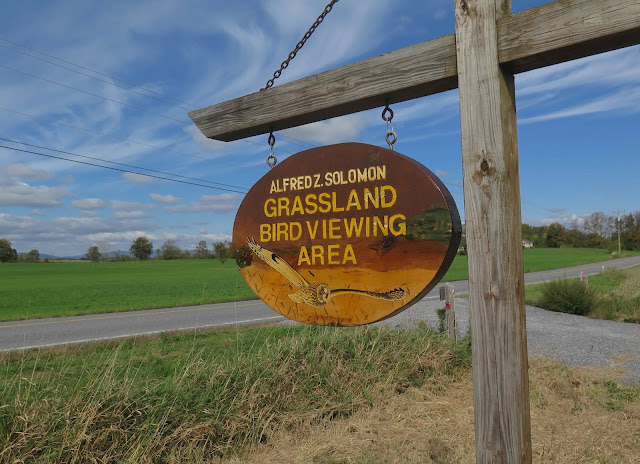Thanks to a post last week on the Flora of New York State's Facebook page, I learned about an aster I'd never heard of before: Glossy-leaved Aster (Symphyotrichum firmum). I believe lots of folks have never heard of it either, since it's not described in my Newcomb's Wildflower Guide nor my Peterson's Field Guide to Wildflowers nor my Audubon Society's Field Guide to North American Wildflowers (East). And when I looked for it on the Native Plant Trust's Go Botany website, I was sent to the page for the closely related Swamp Aster (Symphyotrichum puniceum), a similar-looking species with which S. firmum is occasionally lumped.
Our New York Flora Association's Plant Atlas does indeed list S. firmum among our state's native asters, though. But it lists it as vouchered from only four counties in New York State, all of them far away from the Washington County site where masses of it have recently been observed by state botanists. Thankfully, that site is located not far from me, so my friend Ruth Brooks and I headed off to the Alfred Z. Solomon Grassland Bird-Viewing Area near Fort Edward to have a look at this aster for ourselves.
This extensive Washington County Grassland site is quite famous among birders, and is, in fact, named as one of our state's Important Bird Areas. It encompasses 13,000 acres of critical grassland habitat located along the Atlantic and Hudson River flyways in upstate New York, hosting abundant populations of grassland breeding birds and wintering raptors, including Snowy Owls and state-endangered Short-eared Owls, among other birds of concern.
From Flora of North America:
57. Symphyotrichum firmum (Nees) G. L. Nesom, Phytologia. 77: 282. 1995.
Glossy-leaved aster
Aster firmus Nees, Syn. Aster. Herb., 25. 1818; A. lucidulus (A. Gray) Wiegand; A. puniceus Linnaeus var. firmus (Nees) Torrey & A. Gray
Perennials, 40–250 cm, colonial; long-rhizomatous. Stems 1, erect (straight, ± thin, 2–8 mm diam at base, ± ribbed, red above each node), glabrous or glabrate (very sparsely hispidulous) proximally to ± hispidulous distally. Leaves (crowded, light green, shiny) firm, margins crenulate-serrate or entire, revolute, apices acute to acuminate, mucronate, abaxial faces glabrous or midveins sometimes with hairs apically, adaxial glabrous; basal withering by flowering, subpetiolate (petioles dilated, winged, sheathing), blades spatulate to oblanceolate, 30–100+ × 3–20+ mm, bases attenuate to cuneate, margins remotely crenate-serrate to subentire, apices acute to rounded; proximal cauline withering by flowering, sessile or subpetiolate (petioles widely winged, clasping), blades oblanceolate, 50–150 × 20–30 mm, greatly reduced distally, bases auriculate, clasping, apices acute to acuminate; distal sessile, blades lanceolate to lance-elliptic to oblanceolate, 40–70 × 10–25 mm, little reduced distally, bases auriculate, clasping, margins entire, apices acute to acuminate. Heads in densely paniculiform arrays, branches ascending, densely leafy (branch leaves often overtopping heads). Peduncles 0.2–3+ cm, glabrous or pilose in lines, bracts 4–6, lanceolate-linear, often subtending heads. Involucres campanulate, 6–12 mm. Phyllaries in 4–5(–6) series, linear-lanceolate to linear, slightly unequal, bases indurate 1 / 5 – 1 / 2 , margins not scarious (outer) to narrowly scarious, erose, hyaline, sparsely ciliolate, green zones linear-lanceolate, outer sometimes ± foliaceous, apices acute to acuminate or long-acuminate to caudate, faces glabrous. Ray florets 20–40; corollas usually blue to pale lavender, sometimes white, laminae 9–18 × 1.0–1.2 mm. Disc florets 30–50; corollas yellow or cream becoming pink or purple, (4.5–)5–6.4 mm, tubes shorter than funnelform throats, lobes triangular to lanceolate, 0.6–0.9 mm. Cypselae purple or brown, obovoid, oblong or oblanceolate, ± falcate, ± compressed, 1.5–3 mm, 3–4-nerved, faces glabrous or sparsely strigillose; pappi white, 5.2–8 mm. 2n = 16.
Flowering Aug–Oct. Open, wet soils, spreading into mesic mineral soils, fens, marshes, wet roadsides; 100–400 m; Alta., Man., Ont., Sask.; Ga., Iowa, Mich., Minn., Mo., Nebr.
The range of this little known species is badly defined because some specimens attributed to it are in fact white-rayed, glabrate forms of Symphyotrichum puniceum. More work is needed to verify the status of this species.








Nice Post! THAT aster, the taxonomists haven't agreed on it for a long time IMO. I think it was grouped by some with puniceus/m for awhile. It's really common in the southeast MI wetland habitats, and it "clumps" like your photos show, in addition to often being more "blue-ish" than the bright white S. puniceum in similar habitats. Check it out in Michigan Flora online.
ReplyDeletehttps://michiganflora.net/record/483
I don't recall read it called "glossy-leaved aster" anywhere. Regardless, don't really worry about the common names on these things because the experts who write the books don't care about common names - it's either "my" scientific name (btw- experts don't agree on all those either!) otherwise, call them by whatever common name you want, they don't care! (I agree with you, I don't remember noting their leaves are "glossy" either.)
The cheeses - the deer browse them heavily in my "overgrown" yard...
Because I could not find S. firmum in any of my now out-of-date wildflower guides, I assumed that Symphyotrichum (or Aster) firmum was a recent taxonomic re-naming. Or new discovery. But I've been told it's included in the 1991 Gleason and Cronquist manual. And although New York rates this species as S4 (ostensibly secure), it has been vouchered for only 4 other counties, and not yet for this Washington County. I'm sure it's simply been overlooked or mistaken for S. puniceum. (Although in the field, it has quite a different , more tightly clustered appearance than that aster.)
Delete